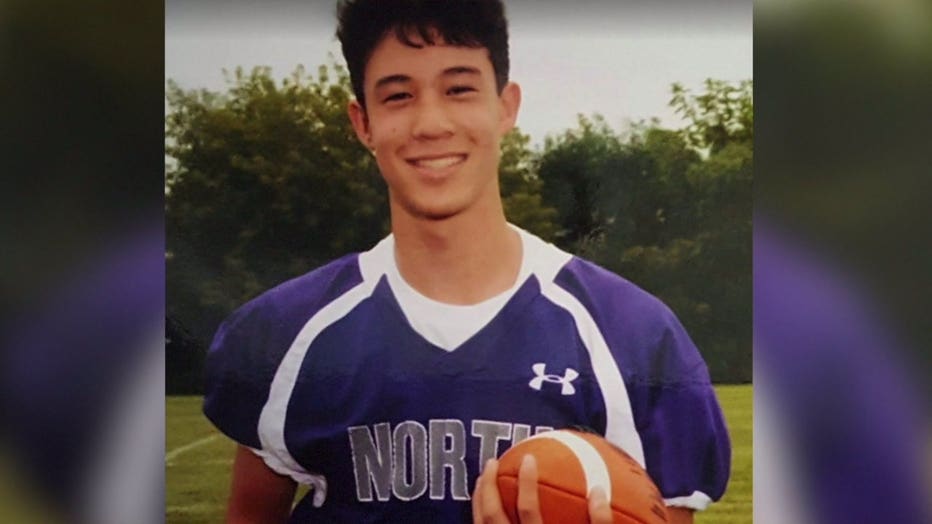NFL player suffers cardiac arrest, Waukesha family knows pain
NFL player suffers cardiac arrest, Waukesha family knows pain
Buffalo Bills safety Damar Hamlin suffered cardiac arrest on the field. In 2019, Waukesha student-athlete Kai Lermer died from cardiac arrest.
WAUKESHA, Wis. - Buffalo Bills safety Damar Hamlin suffered cardiac arrest on the field during Monday night's NFL game against the Cincinnati Bengals.
The mother of Kai Lermer, a Waukesha North High School student-athlete who died from cardiac arrest in 2019, said it is a painful reminder. Since Kai's death, there have been statewide heart health advancements made in his memory.
"It was definitely close to heart – it brought back a lot of memories," said Patty Lermer.
SIGN UP TODAY: Get daily headlines, breaking news emails from FOX6 News
Lermer knew all too well what Hamlin's family, friends and fans were thinking.
"I’ve seen parents say, ‘It’s not going to happen to us. Our son or daughter is so healthy,'" Lermer said. "We thought the same thing."

Kai Lermer
Gov. Tony Evers signed the Kai 11 bill into law in March 2022, requiring schools and the WIAA to distribute information on the risks of sudden cardiac arrest.
"I believe the parents are getting educated on sudden cardiac arrest, and they are taking advantage of the screenings," Lermer said of the Kai Lermer Memorial Fund's work.
FREE DOWNLOAD: Get breaking news alerts in the FOX6 News app for iOS or Android.
Doctors say families' No. 1 goal should be knowing their family heart history.
"People with underlying heart disease who might have fatal arrhythmias – this is diffident than, I think probably, the situation last night," Dr. Tom Wozniak, a cardiothoracic surgeon with ProHealth Care in Waukesha and president of the Greater Milwaukee American Heart Association, said of Hamlin's sudden collapse. "This was most likely induced by blunt trauma, which can happen to anyone with a normal heart.
"Cardiac arrest is when the heart stops functioning normally. Either it stops beating altogether, or it can go into a rhythm that makes the heart not pump effectively."
Doctors are still evaluating Hamlin. Lermer said her son had an undiagnosed heart condition. It's the reason the Kai Lermer Memorial Fund conducts EKG screenings at local high schools. The family said early detection can save broken hearts.
"We were blindsided," she said. "We don’t want anyone being blindsided. It’s the worst tragedy."
School districts have made changes because of the Kai Lermer Memorial Fund's efforts; the School District of Waukesha has posted its policy online.

Damar Hamlin of the Buffalo Bills on Oct. 9 in Orchard Park, New York. (Photo by Bryan Bennett/Getty Images)
Cardiac arrest FAQs
The American Heart Association has information and resources available regarding cardiac arrest. That information is available below:
What is cardiac arrest?
- Cardiac arrest is caused when the heart’s electrical system malfunctions. The heart stops beating properly. The heart’s pumping function is "arrested," or stopped. In cardiac arrest, death can result quickly if proper steps aren’t taken immediately. Cardiac arrest may be reversed if CPR is performed and a defibrillator shocks the heart and restores a normal heart rhythm within a few minutes.
- It can come on suddenly or in the wake of other symptoms. Cardiac arrest is often fatal if appropriate steps aren’t taken immediately. More than 350,000 cardiac arrests occur outside a hospital in the U.S. each year.
What are the causes of cardiac arrest?
- Cardiac arrest may be caused by almost any known heart condition.
- Most cardiac arrests occur when a diseased heart’s electrical system malfunctions. This malfunction causes an abnormal heart rhythm such as ventricular tachycardia or ventricular fibrillation. Some cardiac arrests are also caused by extreme slowing of the heart’s rhythm (bradycardia).
- Irregular heartbeats such as these are life threatening.
- When a person has a cardiac arrest, survival depends on immediately receiving CPR from someone nearby. According to the American Heart Association, about 90% of people who suffer out-of-hospital cardiac arrests die. CPR, especially if performed immediately, can double or triple a cardiac arrest victim’s chance of survival. Yet, bystanders only perform CPR 46% of the time.
- While medical staff on site rushed to Hamlin on the field, for the general public the two steps of hands-only CPR are to call 911 and push hard and fast in the center of the chest. Use a familiar song to help you keep up the pace of 100-120 beats per minute.
Is a heart attack the same as cardiac arrest?
- No. The term "heart attack" is often mistakenly used to describe cardiac arrest. While a heart attack may cause cardiac arrest, the two aren't the same.
Another emergency where CPR and/or AED's might be used is commotio cordis, or the lethal disruption of heart rhythm that occurs as a result of a blow to the area directly over the heart at a critical time during the cycle of a heartbeat. While rare, this is a condition that could affect anyone playing a contact sport. Commotio cordis occurs mostly in boys and young men (average age 15), usually during sports, often despite a chest protector. Being less developed, the thorax of an adolescent is likely more prone to this injury given the circumstances.
Automated external defibrillators have helped increase the survival rate to 35%. Defibrillation must be started as soon as possible (within three minutes) for maximal benefit. Commotio cordis is the leading cause of fatalities in youth baseball in the U.S., with two to three deaths per year. It has been recommended that "communities and school districts reexamine the need for accessible automatic defibrillators and cardiopulmonary resuscitation-trained coaches at organized sporting events for children."
Additional resources:
American Heart Association source: Commotio cordis: a scientific statement from the American Heart Association and American College of Cardiology. Circulation.

